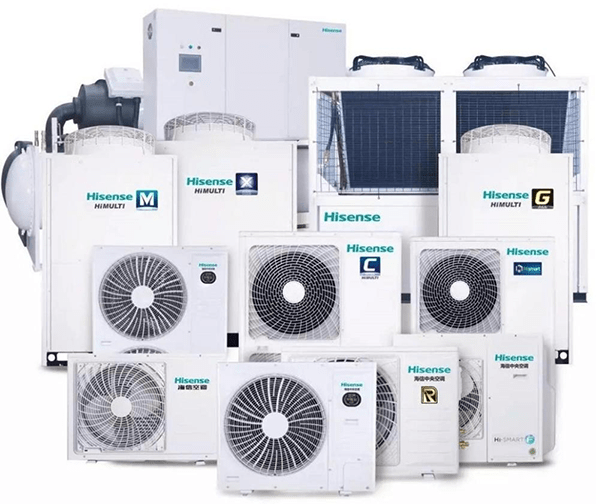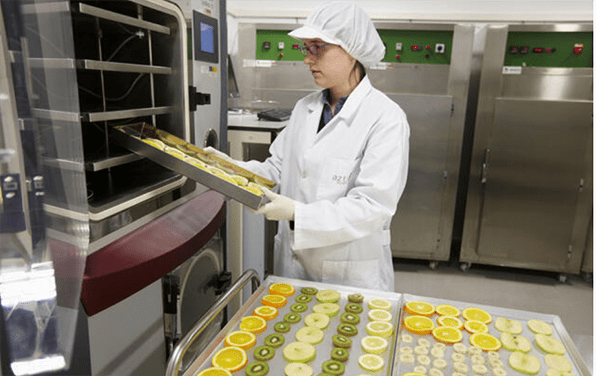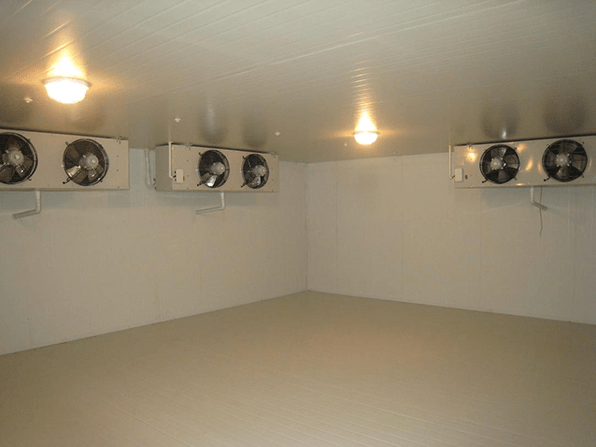
Figure 1: Refrigerant gas tanks.
1. 0HFC Series Refrigerants: R134a, R410A, R407C, R417A, R404A, R507, R23, R508A, R508B, R152a
1.1 R134a (Tetrafluoroethane)
Refrigerant R134a is currently one of the internationally recognized main working fluids that can replace R12. It
can be used as a foaming agent in the production of hard plastic insulation materials, and can also be used to
prepare other mixed refrigerants, such as R404A and R407C.
Main uses: Mainly used as a refrigerant instead of R12, commonly used in vehicle air conditioners,
commercial and industrial refrigeration systems.
1.2 R410A
At normal temperatures and pressures, R410A is a chlorine-free fluoroalkyl non-azeotropic mixed refrigerant. It is a
colorless gas, and is a compressed liquefied gas if stored in a cylinder. Its ODP (Ozone Depletion Potential) is 0,
so R410A is an environmentally friendly refrigerant that does not damage the ozone layer of the atmosphere.
Main uses: R410A is mainly used to replace R22 and R502. It has the characteristics of cleanliness,
low toxicity, non-flammability, and good cooling effect. It is widely used in household air-conditioning, small
commercial air-conditioning, household central air-conditioning, etc.
1.3 R407C
At normal temperatures and pressures, R407C is a chlorine-free fluoroalkyl non-azeotropic mixed refrigerant. It is a
colorless gas, and is a compressed liquefied gas if stored in a cylinder. Its ODP is 0, so R407C is an
environmentally friendly refrigerant that does not damage the atmospheric ozone layer.
Main uses: R407C is mainly used to replace R22. It has the characteristics of cleanliness, low
toxicity, non-flammability, and good cooling effect. It is widely used in household air-conditioning and small and
medium-sized central air-conditioning.
1.4 R417A
At normal temperatures and pressures, R417A is a chlorine-free fluoroalkyl non-azeotropic mixed refrigerant. It is a
colorless gas, and is a compressed liquefied gas if stored in a cylinder. Its ODP is 0, so R417A is an
environmentally friendly refrigerant that does not damage the ozone layer of the atmosphere.
Main uses: R417A is mainly used to replace R22. It has the characteristics of cleanliness, low
toxicity, non-flammability, and good cooling effect. It is used in heat pumps (OEM initial installation to replace
R22) and air conditioners (after-sales replacement of R22), etc.
1.5 R404A
R404A is a non-azeotropic mixed refrigerant that does not contain chlorine. It is a colorless gas under normal
temperature and pressure. It is a compressed liquefied gas stored in a cylinder. Its ODP is 0, so R404A is an
environmentally friendly refrigerant that does not damage the atmospheric ozone layer.
Main uses: R404A is mainly used to replace R22 and R502. It has the characteristics of cleanliness,
low toxicity, non-flammability, and good refrigeration effect. It is widely used in medium and low temperature
freezing systems.
1.6 R507
R507 is a chlorine-free azeotropic mixed refrigerant. It is a colorless gas under normal temperature and pressure.
It is a compressed liquefied gas stored in a cylinder. Its ODP is 0, so R507 is an environmentally friendly
refrigerant that does not damage the atmospheric ozone layer.
Main uses: R507 is mainly used to replace R22 and R502. It has the characteristics of cleanliness,
low toxicity, non-flammability, and good refrigeration effect. It is widely used in medium and low temperature
freezing systems.
1.7 R23 (Trifluoromethane, FREON 23)
The boiling point under normal pressure is -82.1℃, freezing point is -155.2℃, liquid density (25℃) is 0.67 kg/L,
critical density is 0.525kg/L, critical pressure is 4.83 MPa, its ODP is 0 and it is an environmentally friendly
refrigerant.
Main uses: Trifluoromethane, also known as HFC-23, is a high-pressure liquefied gas that can be
used as a refrigerant to replace CFC-13. At the same time, it is an ideal substitute for Halon 1301, with the
characteristics of cleanliness, low toxicity, and good fire extinguishing effect.

Figure 2: Different types of refrigerants.
1.8 R508A
R508A is a chlorine-free azeotropic mixed refrigerant. It is a colorless gas under normal temperature and pressure.
It is a compressed liquefied gas stored in a cylinder. Its ODP is 0, so R508A is an environmentally friendly
refrigerant that does not damage the atmospheric ozone layer.
Main uses: R508A is mainly used to replace R13, R23, and R503. It has the characteristics of
cleanliness, low toxicity, non-flammability, and good refrigeration effect. It is widely used in ultra-low
temperature freezing systems, such as medical refrigeration and scientific research refrigeration.
1.9 R508B
R508B is a chlorine-free azeotropic mixed refrigerant. It is a colorless gas under normal temperature and pressure.
It is a compressed liquefied gas stored in a cylinder. Its ODP is 0, so R508A is an environmentally friendly
refrigerant that does not damage the atmospheric ozone layer.
Main uses: R508B is mainly used to replace R13, R23, and R503. It has the characteristics of
cleanliness, low toxicity, non-flammability, and good refrigeration effect. It is widely used in ultra-low
temperature freezing systems, such as medical refrigeration and scientific research refrigeration.
1.10 R152a (Difluoroethane)
HFC-152a (1,1-difluoroethane CH3CHF2): molecular weight 66.1, boiling point -24.7℃, critical temperature 113.5℃,
critical pressure 4.58MPa, flammable limit in air 5.1-17.1% (V/V), ODP 0.
Main uses: Mainly used as refrigerants, foaming agents, aerosols and cleaning agents, and also an
important component of mixed working fluid.
1.11 R32
Difluoromethane, chemical formula: CH2F2. It is a gas at normal temperature and a colorless and transparent liquid
under its own pressure. It is easily soluble in oil and difficult to dissolve in water. It is a refrigerant with
zero ODP.
Main uses: Similar to R410A, it can be used for household air-conditioning, small commercial
air-conditioning, household central air-conditioning, etc.

Figure 3: Different types of air-conditioning equipment.
2. HCFC Series Refrigerants: R22, R123, R124, R141b, R142b, R402A, R402B, R408A, R409A
2.1 R22 (Difluorochloromethane)
R22 (Freon22, Chlorodifuoromethane): molecular formula CHClF2, molecular weight 86.47. R-22 is a colorless, almost
odorless gas at room temperature. It is non-flammable, non-corrosive and has minimal toxicity. It can be liquefied
into a colorless and transparent liquid under pressurization and is an HCFC refrigerant.
R-22 has high chemical stability and thermal stability, especially in the absence of moisture, and it does not react
with ordinary metals below 200°C. In the presence of water, it only reacts slowly with alkalis. However, splitting
decomposition occurs at high temperatures.
Main uses: R-22 is widely used in household air-conditioning, central air-conditioning and other
commercial refrigeration equipment; it can also be used as a raw material for polytetrafluoroethylene resin and an
intermediate for fire extinguishing agent 1121.
2.2 R123 (Dichlorotrifluoroethane)
Trifluorodichloroethane (2,2-dichloro-1,1,1-trifluoroethane): molecular formula CF3CHCl2, molecular weight 152.93,
boiling point 27.85 ℃, ODP 0.02, global warming potential ( GWP) 93. It is an HCFC refrigerant that replaces R-11
(F11).
Main uses: R123 can replace F-11 and F-113 as cleaning agent, foaming agent and refrigerant (used
in central air conditioning/centrifugal chiller).
2.3 R124 (Chlorotetrafluoroethane)
Monochlorotetrafluoroethane CHClFCF3, HCFC-124 (R124): molecular weight 136.5, boiling point -10.95°C, critical
temperature 122.25°C, critical pressure 3.613MPa, ODP 0.02, GWP 0.10.
Main uses: HCFC-124 (R124) is mainly used as a refrigerant and fire extinguishing agent. It is an
important component of mixed working fluid and can replace CFC-114.
2.4 R141b (Dichlorofluoroethane)
Dichlorofluoroethane CH3CCl2F, HCFC-141b, has a molecular weight of 116.95, a boiling point of 32.05°C, a critical
temperature of 204.5°C, a critical pressure of 4.25MPa, an ODP of 0.11, and a GWP of 0.09.
Main uses: This product can replace CFC-11 as a blowing agent for rigid polyurethane foam, replace
CFC-113 as a cleaning agent, and can also be used as a refrigerant.
2.5 R142b (Chlorodifluoroethane)
Monochlorodifluoroethane CClF2CH3, HCFC-142b, has a boiling point of -9.2°C, a critical temperature of 136.45°C, and
a critical pressure of 4.15MPa. It is a colorless gas at room temperature with a slightly aromatic smell. It is
easily soluble in oil and difficult to dissolve in water.
Main uses: HCFC-142b (R-142b) is mainly used as an intermediate for refrigeration systems in
high-temperature environments, thermostatic control switches and aviation propellants, and can also be used as
chemical raw materials.
2.6 R402A
R-402A consists of: R-22, R-290 and HFC-125. It is a HCFC service-type mixed refrigerant. It complies with the A1
safety class category of the American Society of Heating, Refrigeration and Air-Conditioning Engineers (ASHRAE)
(this is the highest level and is harmless to the human body); it complies with the standards of the US
environmental organizations EPA, SNAP and UL. It is recommended to use alkylbenzene AB synthetic oil as
refrigeration oil.
Main uses: Substitute for R-502 in commercial refrigeration equipment and some transportation
refrigeration facilities. It is suitable for all environments where R-502 can operate normally.
2.7 R402B
R-402B is composed of: R-22, R-290 and HFC-125. It is a HCFC service-type mixed refrigerant. It complies with the A1
safety class category of the ASHRAE; it complies with the standards of the US environmental organizations EPA, SNAP
and UL. It is recommended to use alkylbenzene AB synthetic oil as refrigeration oil.
Main uses: Replace R-502 for large commercial refrigeration equipment, such as ice machines, etc.
It is applicable to all environments where R-502 can operate normally.
2.8 R408A
R408A refrigerant is a mixed working fluid composed of R22, R125, and R143a. It is a colorless gas at room
temperature, and has a molecular weight of 87.01, a boiling point of -44.4°C, a critical temperature of 83.8°C, a
critical pressure of 4.42MPa, and an ODP of 0.016.
Main uses: R408A refrigerant is mainly used to replace R502.
2.9 R409A
R409A is a mixture of HCFC-22, HCFC-124 and HCFC-142b and is a colorless gas at room temperature. The molecular
weight is 97.4, the boiling point is -34.5°C, the critical temperature is 106.8°C, the critical pressure is 4.69MPa,
and the ODP is 0.039.
Main uses: R409A is a substitute for R12 and is mainly used in refrigeration systems.

Figure 4: Air conditioner outdoor units.
3. CFC Series Refrigerants: F11, R12, R13, R502, R503
3.1 R11 (Trichlorofluoromethane)
Alias Freon-11 (FREON 11): molecular formula CCl3F, molecular weight 137.37. Colorless liquid or gas, melting point
-111°C, boiling point 23.7°C. It has an ether smell, is slightly soluble in water, is easily soluble in ethanol and
ether, and has good chemical stability.
Main uses: used as refrigerant for large central air-conditioning (centrifugal chillers) and
polyurethane (PU) foam foaming agent.
3.2 R12 (Dichlorodifluoromethane)
R12 is a colorless, odorless, non-corrosive gas at room temperature, and can be liquefied into a colorless and
transparent liquid under pressurization. R12 is non-toxic, non-flammable and has good thermal and chemical
stability.
Main uses: R12 can be used as a refrigerant, fire extinguishing agent, insecticide, spray, etc. As
a refrigerant, R12 is widely used in refrigeration and air conditioning fields such as refrigerators, freezers, and
central air conditioning chillers.
3.3 R13 (Chlorotrifluoromethane)
R13: molecular formula is CClF3, molecular weight is 104.5, boiling point under normal pressure is -81.4℃, freezing
point is -181℃, liquid density (-30℃) is 1.298kg/L, ODP is 1.0, GWP is 17.5.
Main uses: Mainly used as low temperature/ultra-low temperature refrigerants.
3.4 R502
R502 is a mixed working fluid, composed of R22/R115, with a molecular weight of 111.63 and a boiling point of
-45.6°C. It is a non-flammable substance.
Main uses: Mainly used as a low-temperature refrigeration working fluid. It can be used as a
refrigerant for food display, food storage, refrigeration, ice cream machines, low-temperature refrigerators and
low-temperature freezing compressors.
3.5 R503
R503 is a mixed working fluid, composed of R13/R23, with a boiling point of -87.9°C and is a non-flammable
substance.
Main uses: Mainly used in ultra-low temperature refrigeration equipment, such as low temperature
test chambers and freeze-drying equipment.

Figure 5: Freeze-dried fruit production.
4. PFC Series Refrigerants: PFC-14, PFC-116, PFC-218
4.1 PFC-14 (Tetrafluoromethane)
Carbon Tetrafluoride or Tetrafluoromethane, also known as PFC-14 (R-14): molecular formula CF4, relative molecular
weight 88.00, boiling point -128℃, melting point -183.6℃, liquid density (-130℃) 1.613g/cm3, critical temperature
-45.67℃, critical pressure 3.74MPa, vapor pressure (-150.7℃) 13.33kPa, dielectric constant (25℃, 0.5MPa) 1.0006. At
room temperature, it is a colorless, odorless, non-flammable, water-insoluble, compressible gas.
It is highly volatile and one of the most stable organic compounds. At 900 degrees Celsius, it does not react with
steel, nickel, tungsten, or molybdenum, and only decomposes slowly at carbon arc temperature. It is slightly soluble
in water and its solubility is 0.0015% (weight ratio) at 25 degrees Celsius and 0.1MPa. However, when burned with
flammable gases, it will decompose to produce toxic fluoride.
Main uses: Mainly used in plasma etching processes of various integrated circuits, and also used as
coolants for laser gases, low-temperature refrigerants, solvents, lubricants, insulating materials, and infrared
detector tubes.
4.2 PFC-116 (Hexafluoroethane, Perfluoroethane)
It is colorless, non-toxic, non-corrosive, non-flammable and extremely stable liquefied gas.
Molecular Weight: 138.01, Critical Temperature: 68°F, Critical Pressure: 432 Psia, Boiling Point: -108.8°F (-78.2°C)
@ 1 atm, Gas Density: 0.361lb/cf @NTP.
Hazards: Heating it will produce toxic by-products.
Main uses: Mainly used as insulating gas, plasma etching agent, high dielectric strength coolant,
etc. It is also commonly used as a component of ultra-low temperature blended refrigerants.
4.3 PFC-218 (Octafluoropropane, Perfluoropropane)
Alias: perfluoropropane, molecular formula: C3F8. It is colorless, non-flammable gas and is a low-pressure liquefied
gas at normal temperature.
It is chemically inactive and has good thermal stability. It will neither corrode nor decompose when in contact with
glass, silicon steel, and mild steel at 280°C for more than 6 months. In the process of handling octafluoropropane,
it can be treated as a non-toxic gas, but when burned together with flammable gas, it decomposes to produce toxic
fluoride.
Main uses: Used in plasma etching in the microelectronics industry, as well as device surface
cleaning, low-temperature refrigeration, medical gas, gas insulation, etc.

Figure 6: Cold storage refrigeration.
5. HC Series Refrigerants: R170, R290, R600a, R1270
5.1 R170 (Ethane)
Ethane C2H6 (R170) has a molecular weight of 30.07, a boiling point of -88.6°C, a critical temperature of 32.3°C, a
critical pressure of 5.88 MPa, an ODP of 0, and a GWP of 0.01.
Main uses: R170 is mainly used to replace R13 and R503, and is compatible with the original system
and lubricants.
5.2 R290 (Propane)
Propane CH3CH2CH3 (R290): molecular weight 44.9, boiling point -42.2℃, critical temperature 96.67℃, critical
pressure 4.24MPa, vapor pressure (25℃) 0.475MPa, ODP 0, GWP 0.01.
Main uses: High-purity grade R290 is used as a temperature-sensing working fluid; premium grade and
first-grade R290 can be used as refrigerants to replace R22 and R502, and are compatible with the original system
and lubricating oil.
5.3 R600a (Isobutane)
Isobutane (CH3) 2CHCH3 (R600a) has a molecular weight of 58.12, a boiling point of -11.80°C, a critical temperature
of 134.98°C, a critical pressure of 3.66MPa, an ODP of 0, and a GWP of 0.1.
Main uses: R600a refrigerant is mainly used to replace CFC-12 refrigerant used in refrigerators,
freezers and other refrigeration equipment.
5.4 R1270 (Propylene)
Propylene C3H6 (R1270) has a molecular weight of 42.08, a boiling point of -47.7°C, a critical temperature of
91.4°C, a critical pressure of 4.67MPa, and an ODP of 0.
Main uses: R1270 is mainly used to replace R502 and R143a refrigerants, and is compatible with the
original system and lubricating oil.


